Barred owls may doom old-growth ecosystems
Written by George Sexton, January 2024
Credit: Larry Eifert
The old-growth forests of the Pacific Northwest have long been touted as havens of biodiversity in which an interconnected web of life supports a complex and magnificent ecosystem. The relationship of predators to prey and mycorrhizal fungi to large tree growth has sustained ancient forests in our region for millennia. Many consider these old-growth forest ecosystems to be an irreplicable ecological and cultural treasure.
Barred Owl Range Expansion is Human-Caused
As European settlement and agriculture dramatically altered both the great plains and the Canadian boreal forests, barred owls that were native to the East Coast of North America spread west through Canada and then down the West Coast, outcompeting and displacing Northern spotted owls as they arrived and dramatically undermining some forest ecosystem functions.
An Avian Vacuum Cleaner
Most people are familiar with the dramatic reduction in the range and presence of ancient forest ecosystems that resulted from decades of rapacious logging practices. Now, many of us see and recognize the increased loss of green multi-storied complex old-growth forests from climate change-induced stand-replacing fires. But it is much harder for the human eye to see the way in which human-induced barred owl encroachment is unraveling the fabric of forest ecosystems.
Left: Barred owl, Right: Northern spotted owl. Credit: National Park Service
Barred owls are larger and more aggressive than the avian predators that rodents, lizards, amphibians, burrowing mammals, arboreal mammals, and birds evolved with in the Pacific Northwest. Additionally, compared to native owl species, barred owls have extremely small territories, such that their density in the forest is far higher than that of native avian predators. This combination of size and density of a predator species that prey species have not evolved to evade is threatening to cause what’s known as a “trophic cascade” in which old-growth forest ecosystems may cease to function as the predator-prey relationship is thrown off kilter. Everything from soil nutrient cycling to mycorrhizal fungi production and tree growth is tied together and reliant upon the continued presence of numerous small wildlife species that barred owls prey upon.
An Ethical Dilemma
Wildlife biologists in the US Fish and Wildlife Service have proposed an ambitious barred owl removal program with a particular focus on trying to stem the precipitous loss of Northern spotted owls from the competitive habitat encroachment. That plan is detailed here.
The proposal to address barred owl encroachment through lethal removal is extremely controversial. Many good-hearted people are understandably uncomfortable with killing a charismatic and majestic owl to benefit ecosystem processes that are largely invisible. Others question the efficacy of the plan and the ability of the Fish and Wildlife Service to implement it at a scale and timeframe that would be required. Regardless of where one comes down on the ethics of barred owl removal, it is important to remember that barred owls would not be in these forests but for the actions of humans over the past century. Our actions brought barred owls here. Our actions removed most of the ancient forests on the West Coast. Our actions induced climate change. If we are to prevent the extinction of old-growth-associated wildlife species and the collapse of ancient forest ecosystems as humans continue to alter the planet, there will be a number of tough choices in front of us.
Read more about this topic:


